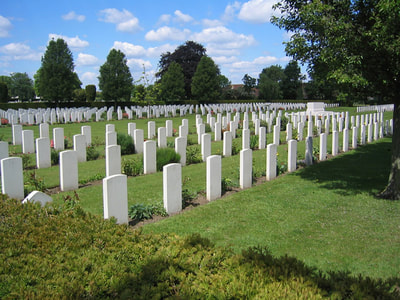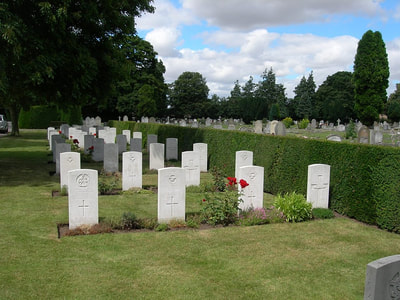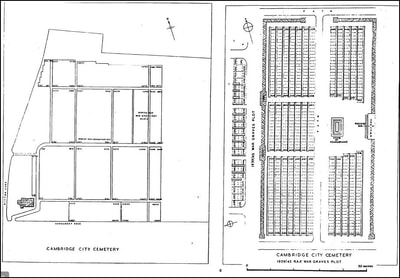CAMBRIDGE CITY CEMETERY
Cambridgeshire
England
Location Information
The cemetery is known locally as Newmarket Road Cemetery, and the site is open daily between 07.00 and 19.00 hours.
The cemetery is located on the north-east outskirts of the city and is close to the airport. It will be found at the junction of Newmarket Road (A1303) and Ditton Lane.
BY CAR:
FROM CITY CENTRE: Follow signs for Newmarket and Airport.
FROM LONDON & SOUTH: Approach Cambridge on the M11. At Junction 11 turn onto the A14 following signs for Newmarket and Ipswich. On the A14 take the third junction off signed for Cambridge, Horningsea and the airport. At the top of the slip road, turn right. After approximately three quarters of a mile there is a parade of shops on the left. The cemetery entrance is a further 100 metres on the left. The car park is on the right immediately after entering the cemetery.
FROM NORTH: Approach Cambridge on the A14 south bound. At the start of the M11 follow signs for the A14 East towards Newmarket and Ipswich. On the A14 take the third junction off signed for Cambrdige, Horningsea and the airport. At the top of the slip road, turn right. After approximately three quarters of a mile there is a parade of shops on the left. The cemetery entrance is a further 100 metres on the left. The car park is on the right immediately after entering the cemetery.
FROM NEWMARKET & THE EAST: Approach Cambridge on the A14 and take the first Cambridge exit which is signed for Stow-cum-Quay, Cambridge and airport. This is the A1303 Newmarket Road. At the top of the slip road turn left towards Cambridge. After passing the airport, on left hand side, the cemetery is on the right hand side. At the end of the cemetery fence is a junction which is controlled by traffic lights. Turn right at the junction into Ditton Lane. The cemetery entrance is approximately 30 metres on right.
BY RAIL - From Railway Station:
Take a taxi and ask for Newmarket Road Cemetery. (DO NOT ask for war cemetery or taxies go to the American Cemetery in Madingley, which is to the west of Cambridge and difficult to get back from.)
Visiting Information
A Visitor Information Panel has recently been installed at Cambridge City Cemetery to provide information about the war casualties buried here. This is one of many panels being erected to help raise awareness of First and Second World War graves in the UK (Apr 2013).
Historical Information
The 1st Eastern General Hospital, with 1,173 beds, was posted to Cambridge during the First World War, initially at the Leys School and Trinity College, later in huts. The First World War burials in Cambridge City Cemetery are mostly in two plots, one in the southern part of the burial ground, known as the Dominion Plot, and the other on the northern boundary. The Cross of Sacrifice stands on the western border of the Dominion Plot, while in the centre of the other is a memorial cross of Portland stone which was erected by private subscription.
The Second World War graves are also mainly in two War Graves Plots with a few others scattered throughout the cemetery The general Service plot was established in 1940, and the Air Force plot in 1942 for the burial of casualties from the Air Force stations set up in the eastern counties during the war. These included Bomber Command bases in Lincolnshire and fighter stations in Norfolk and Suffolk. The Stone of Remembrance, which was unveiled by Marshal of the Royal Air Force Lord Tedder in July 1951, stands near the centre of the Air Force plot.
Cambridge City Cemetery contains 181 Commonwealth burials of the First World War and 829, (inclusive 3 unidentified), from the Second World War. The cemetery also contains four non-war service burials and ten war graves of other nationalities.
Pictures used with the permission of the Commonwealth War Graves Commission
The cemetery is known locally as Newmarket Road Cemetery, and the site is open daily between 07.00 and 19.00 hours.
The cemetery is located on the north-east outskirts of the city and is close to the airport. It will be found at the junction of Newmarket Road (A1303) and Ditton Lane.
BY CAR:
FROM CITY CENTRE: Follow signs for Newmarket and Airport.
FROM LONDON & SOUTH: Approach Cambridge on the M11. At Junction 11 turn onto the A14 following signs for Newmarket and Ipswich. On the A14 take the third junction off signed for Cambridge, Horningsea and the airport. At the top of the slip road, turn right. After approximately three quarters of a mile there is a parade of shops on the left. The cemetery entrance is a further 100 metres on the left. The car park is on the right immediately after entering the cemetery.
FROM NORTH: Approach Cambridge on the A14 south bound. At the start of the M11 follow signs for the A14 East towards Newmarket and Ipswich. On the A14 take the third junction off signed for Cambrdige, Horningsea and the airport. At the top of the slip road, turn right. After approximately three quarters of a mile there is a parade of shops on the left. The cemetery entrance is a further 100 metres on the left. The car park is on the right immediately after entering the cemetery.
FROM NEWMARKET & THE EAST: Approach Cambridge on the A14 and take the first Cambridge exit which is signed for Stow-cum-Quay, Cambridge and airport. This is the A1303 Newmarket Road. At the top of the slip road turn left towards Cambridge. After passing the airport, on left hand side, the cemetery is on the right hand side. At the end of the cemetery fence is a junction which is controlled by traffic lights. Turn right at the junction into Ditton Lane. The cemetery entrance is approximately 30 metres on right.
BY RAIL - From Railway Station:
Take a taxi and ask for Newmarket Road Cemetery. (DO NOT ask for war cemetery or taxies go to the American Cemetery in Madingley, which is to the west of Cambridge and difficult to get back from.)
Visiting Information
A Visitor Information Panel has recently been installed at Cambridge City Cemetery to provide information about the war casualties buried here. This is one of many panels being erected to help raise awareness of First and Second World War graves in the UK (Apr 2013).
Historical Information
The 1st Eastern General Hospital, with 1,173 beds, was posted to Cambridge during the First World War, initially at the Leys School and Trinity College, later in huts. The First World War burials in Cambridge City Cemetery are mostly in two plots, one in the southern part of the burial ground, known as the Dominion Plot, and the other on the northern boundary. The Cross of Sacrifice stands on the western border of the Dominion Plot, while in the centre of the other is a memorial cross of Portland stone which was erected by private subscription.
The Second World War graves are also mainly in two War Graves Plots with a few others scattered throughout the cemetery The general Service plot was established in 1940, and the Air Force plot in 1942 for the burial of casualties from the Air Force stations set up in the eastern counties during the war. These included Bomber Command bases in Lincolnshire and fighter stations in Norfolk and Suffolk. The Stone of Remembrance, which was unveiled by Marshal of the Royal Air Force Lord Tedder in July 1951, stands near the centre of the Air Force plot.
Cambridge City Cemetery contains 181 Commonwealth burials of the First World War and 829, (inclusive 3 unidentified), from the Second World War. The cemetery also contains four non-war service burials and ten war graves of other nationalities.
Pictures used with the permission of the Commonwealth War Graves Commission










